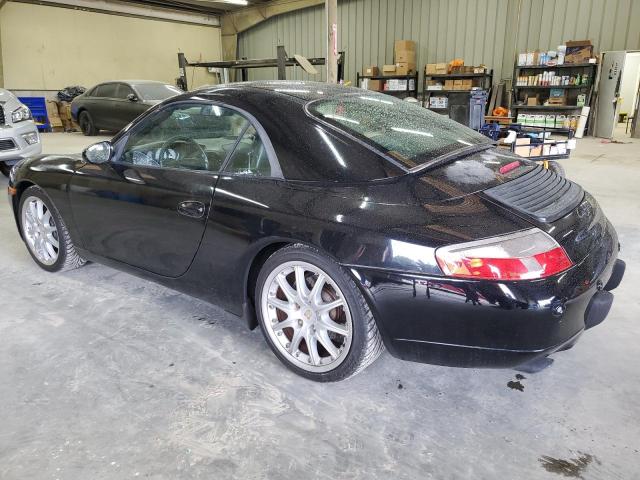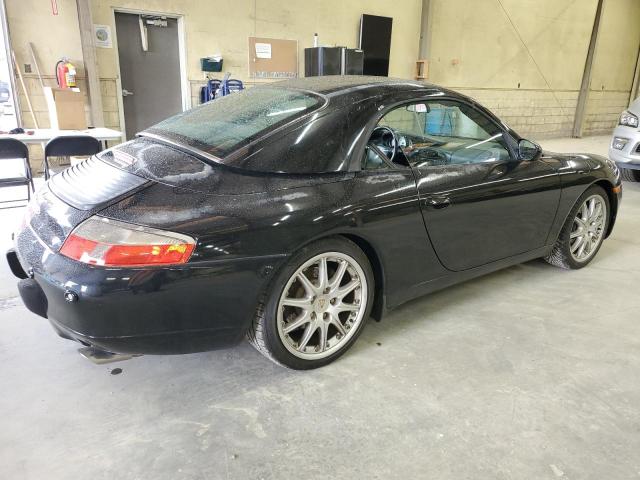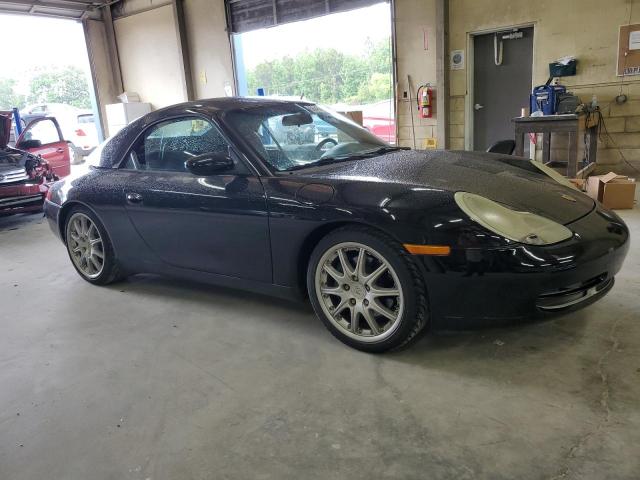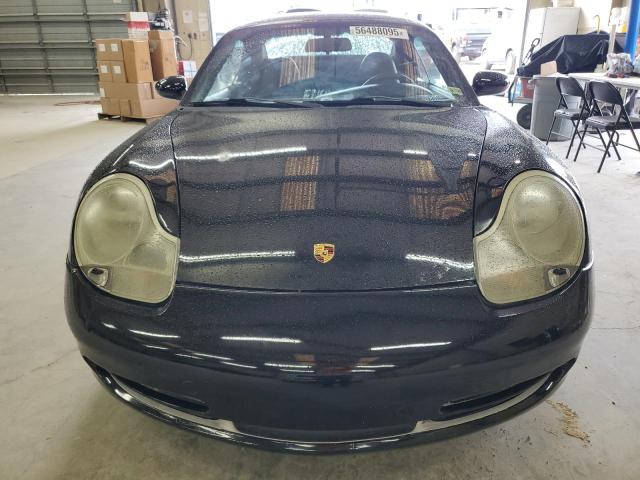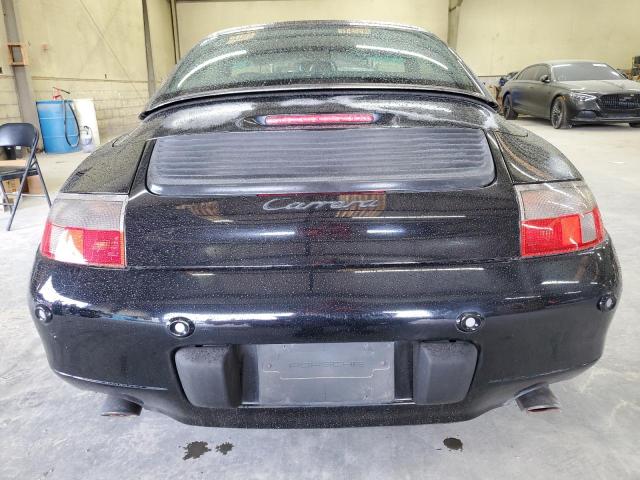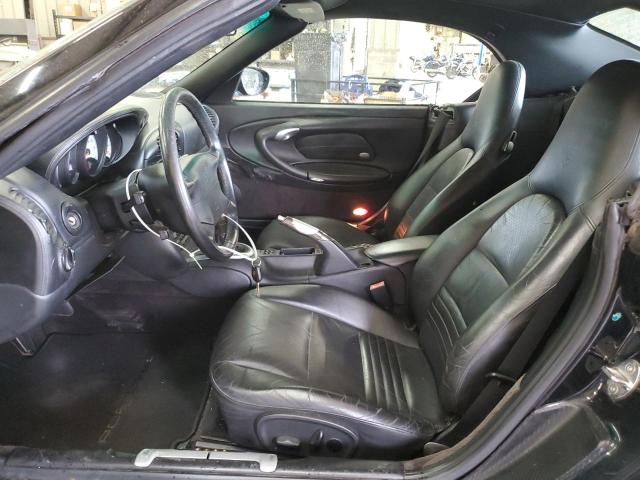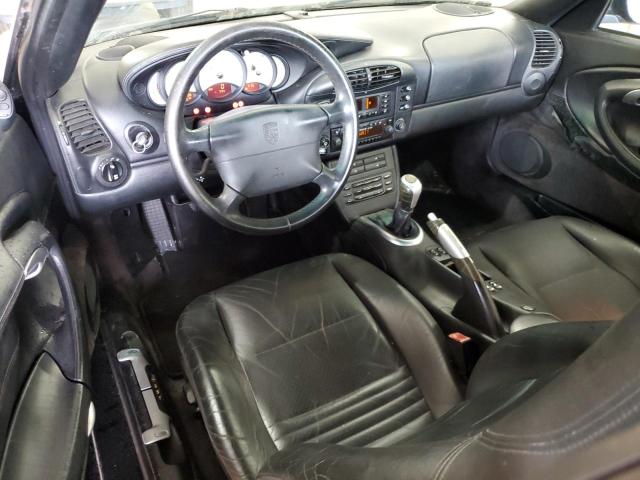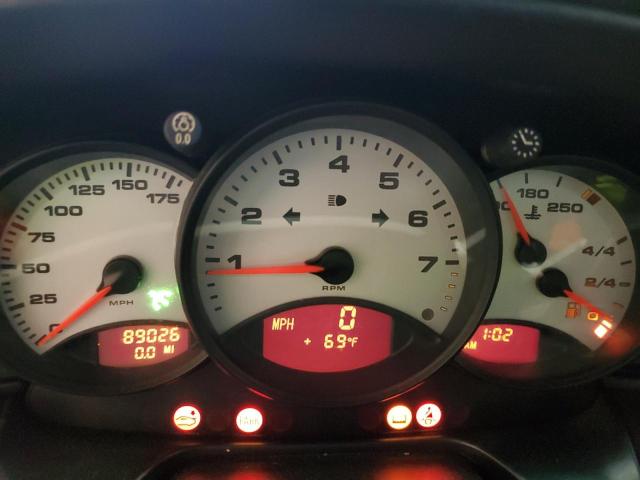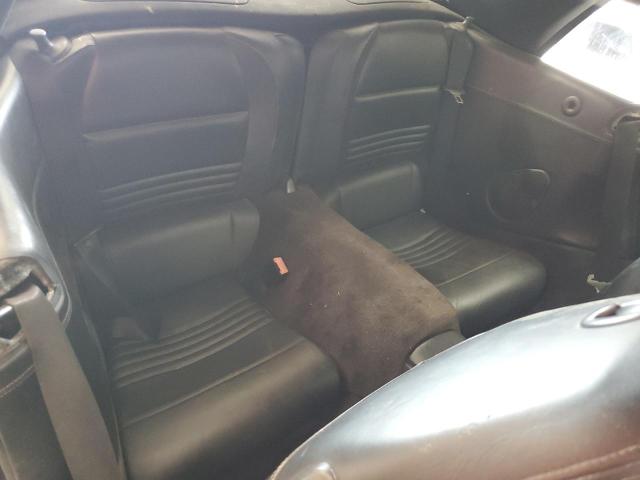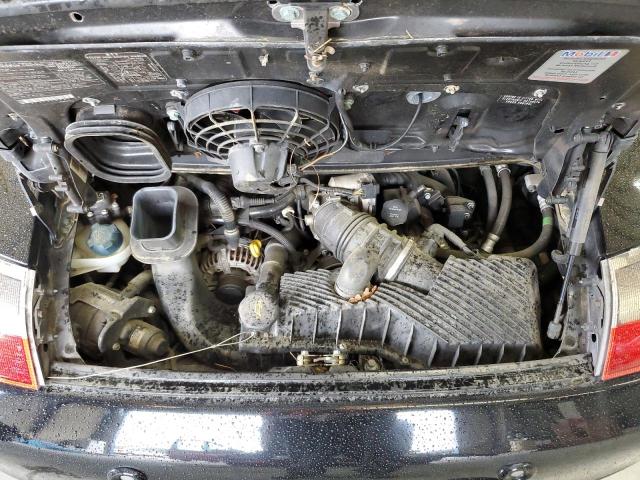2000 PORSCHE 911 | WP0CA2990YS650907
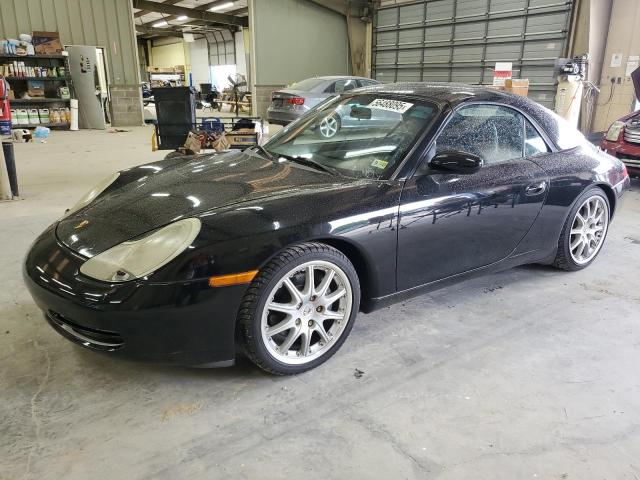 ❯
❯
Specifications
5
~$190,000
Engine: 3.6L twin-turbocharged flat-six
Torque: 640 Nm
0–100 km/h: ~3.9 s
The 996-generation 911 was a turning point in Porsche history, introducing water cooling to the legendary flat-six for the first time. While controversial for purists, it brought substantial gains in power, emissions, and cooling efficiency. At the top of the range was the 911 GT2, a stripped-down, rear-wheel-drive twin-turbo monster, producing 462 hp (later 483 hp) and 640 Nm of torque. With a 6-speed manual, no traction control, and lightweight construction, it accelerated from 0–100 km/h in under 4 seconds, making it the most extreme 911 of its time.
The 911 Turbo (996.2) used a 3.6L twin-turbocharged flat-six derived from the 911 GT1 Le Mans car, delivering 420 hp and 560 Nm, along with all-wheel drive and active suspension. It offered a perfect balance between brutal performance and daily drivability, with 0–100 km/h in 4.2 seconds.
Enthusiasts also embraced the 911 GT3, a naturally aspirated, track-tuned homologation special producing 381 hp and featuring lightweight components, no rear seats, and a manual-only transmission. It offered razor-sharp handling, high-revving thrills, and became the blueprint for every future GT3.
Even base Carrera models delivered serious performance. The 3.4L (996.1) and later 3.6L (996.2) engines powered rear- or all-wheel-drive variants, with outputs ranging from 300 to 320 hp, and 0–100 km/h times between 4.9 and 5.2 seconds. Tiptronic automatic was optional, but manual was standard for maximum driver engagement.
Body Styles
The 996 was available in three main body styles: Coupé, Cabriolet, and Targa. The Coupé featured the iconic 911 fastback silhouette, with a more streamlined profile and integrated bumpers than its predecessors. Compared to the 993, the 996 had a longer wheelbase, wider front track, and rounder body lines. Most notably, it introduced the “fried egg” headlights with integrated indicators — a major styling departure.
The Cabriolet featured a power-operated soft-top and optional hardtop, retaining structural integrity through reinforced sills and windshield frames. The Targa, reintroduced in 2002, used a panoramic sliding glass roof under a fixed frame, offering open-air driving without full exposure. Turbo, GT2, and GT3 were only offered as coupés.
Turbo and GT2 models featured wider rear fenders, larger air intakes, fixed rear wings, and more aggressive aero kits. GT2 and GT3 added front splitters, bucket seats, roll cage options, and lighter construction.
Model Name Meaning (Manufacturer)
The “911” has been Porsche’s flagship designation since the 1960s. The “996” is the internal code for the generation produced between 1997–2004, with the facelift in 2002 (996.2). “Carrera” continues Porsche’s tradition of honoring the Carrera Panamericana race, while “Turbo,” “GT2,” and “GT3” refer to forced induction or track-focused motorsport homologation versions.
Model Name Meaning (Languages)
While “911” is numeric, it is globally synonymous with performance, heritage, and precision. “GT” suffixes imply race-ready engineering; “Turbo” signals power and prestige. In the 996 era, these badges became increasingly differentiated, representing distinct driving philosophies within the 911 range — from comfortable grand touring to hardcore track use.
Body & Interior Colors and Rims
The Porsche 911 (996 generation, 1999–2004) introduced a bold shift in design and engineering, and this was reflected in its color palette, interior detailing, and wheel options — blending 1990s modernism with heritage cues. The 996 was the first 911 to adopt water cooling, and it debuted with a more streamlined, aerodynamic body that showcased paint finishes with new clarity and depth.
Exterior colors included classic Porsche shades like Arctic Silver, Guards Red, Cobalt Blue, Basalt Black, and Speed Yellow, along with refined tones such as Seal Grey, Polar Silver, and Slate Grey Metallic. More exclusive or period-typical options included Orient Red Metallic, Zenith Blue, and Forest Green Metallic. The Porsche Paint to Sample (PTS) program offered special-order finishes, and the GT2, GT3, and Turbo models introduced bolder hues like Carrera White, Riviera Blue, and Zanzibar Red, often paired with body-colored aero kits or distinctive trim.
Inside, the 996's cabin marked a departure from air-cooled minimalism toward more integrated, comfort-oriented design. Interior colors included Black, Graphite Grey, Metropol Blue, Savanna Beige, and Space Grey, with optional two-tone treatments (such as Black/Grey or Black/Terracotta) available on higher trims and through Exclusive options. Materials ranged from standard leather and leatherette to full leather dash and door panels, particularly in Turbo and GT models.
The dashboard featured a more symmetrical design than past 911s, with oval HVAC vents and a center stack housing the PCM system. Trim accents varied from brushed aluminum and carbon fiber to burr walnut or painted interior packages matched to exterior colors. GT3 and GT2 variants featured sport seats, Alcantara headliners, and lightweight deletes (like rear seats and sound insulation) in Clubsport or RS-style builds.
Wheels played a central role in the 996’s updated visual identity. Base Carrera models came with 17-inch 5-spoke “Twist” alloys, while Carrera 4 and 4S variants featured wider 18-inch “Turbo Look” wheels. The 911 Turbo used distinct 18-inch hollow-spoke alloys, sometimes polished or painted, with aggressive offsets and a deep-dish rear profile. The GT3 wore lightweight 18-inch BBS-style forged wheels, while the GT2 received center-lock-style 18-inch wheels with widened rear fitments.
Wheel finishes included Silver, Titanium Grey, Polished Aluminum, and in some cases, body-colored outer spokes. Several optional upgrades included Sport Techno wheels, multi-spoke split rims, or rare OEM BBS mesh patterns. Tire setups were staggered, with wider rears for optimal traction on rear-engine platforms, and Michelin Pilot Sport or Pirelli P Zero tires fitted from the factory.
Behind the wheels, ventilated and cross-drilled disc brakes were standard, with red calipers on Turbo models, yellow on those with Porsche Ceramic Composite Brakes (PCCB), and black or silver calipers on standard trims. These wheels and braking packages helped define the 996’s visual transformation — where modern simplicity met classic 911 functionality, forming a bridge to the digital, performance-driven 2000s.
Top Expensive Options
- PCCB Carbon Ceramic Brakes (GT2/GT3): $8,000
- Full Leather Interior Package: $3,800
- Sport Seats with Power and Memory: $1,600
- Tiptronic S Automatic Transmission (Carrera only): $3,400
- Porsche Communication Management (PCM): $2,100
- Aero Kit X74 / Turbo Aerokit: $5,500
- GT3 Clubsport Package (Cage, Fire Extinguisher, Cut-off Switch): $4,200
- Bose Surround Sound System: $1,200
- Heated Front Seats with Lumbar: $950
- Sunroof (Coupé): $1,000
vs Competitors
The 996-era 911 faced rivals like the Ferrari 360 Modena, Chevrolet Corvette C5 Z06, BMW M3 (E46), and Honda NSX (final years). While the Ferrari offered Italian emotion and the Z06 raw performance per dollar, the 911 excelled in everyday usability, build quality, and engineering purity. The GT3 and GT2 versions especially elevated the 911 into supercar territory — with real-world performance, track credentials, and daily reliability.
Despite early criticism over styling and interior plastics, the 996 remains a turning point for Porsche — introducing modern ergonomics and electronic systems while preserving the rear-engine, flat-six driving soul.
Fun Fact
The 996 Turbo’s engine (coded Mezger M96/70) was directly derived from the Le Mans-winning 911 GT1, making it one of the most durable and desirable engines Porsche ever built. In contrast to the regular Carrera engines, which suffered some IMS bearing issues, the Mezger units were bulletproof, adding to the Turbo, GT2, and GT3’s lasting reputation — and collectibility.
Lot Details
-
Sale Date10/Jun/2025
-
Lot Number56488095
-
Sale document
-
Location
-
Odometer89,026 miles (143,273 km)
-
Primary Damage:MINOR DENT/SCRATCHES
-
Fuel
-
Engine Type3.4L 6
-
Transmission
-
Drive Type
-
Color
Final Bid Porsche 911 (2000)
$10,300
$12,600
$16,000
Specifications
5
~$190,000
Torque:
0–100 km/h:
The 996-generation 911 was a turning point in Porsche history, introducing water cooling to the legendary flat-six for the first time. While controversial for purists, it brought substantial gains in power, emissions, and cooling efficiency. At the top of the range was the 911 GT2, a stripped-down, rear-wheel-drive twin-turbo monster, producing 462 hp (later 483 hp) and 640 Nm of torque. With a 6-speed manual, no traction control, and lightweight construction, it accelerated from 0–100 km/h in under 4 seconds, making it the most extreme 911 of its time.
The 911 Turbo (996.2) used a 3.6L twin-turbocharged flat-six derived from the 911 GT1 Le Mans car, delivering 420 hp and 560 Nm, along with all-wheel drive and active suspension. It offered a perfect balance between brutal performance and daily drivability, with 0–100 km/h in 4.2 seconds.
Enthusiasts also embraced the 911 GT3, a naturally aspirated, track-tuned homologation special producing 381 hp and featuring lightweight components, no rear seats, and a manual-only transmission. It offered razor-sharp handling, high-revving thrills, and became the blueprint for every future GT3.
Even base Carrera models delivered serious performance. The 3.4L (996.1) and later 3.6L (996.2) engines powered rear- or all-wheel-drive variants, with outputs ranging from 300 to 320 hp, and 0–100 km/h times between 4.9 and 5.2 seconds. Tiptronic automatic was optional, but manual was standard for maximum driver engagement.
Body Styles
The 996 was available in three main body styles: Coupé, Cabriolet, and Targa. The Coupé featured the iconic 911 fastback silhouette, with a more streamlined profile and integrated bumpers than its predecessors. Compared to the 993, the 996 had a longer wheelbase, wider front track, and rounder body lines. Most notably, it introduced the “fried egg” headlights with integrated indicators — a major styling departure.
The Cabriolet featured a power-operated soft-top and optional hardtop, retaining structural integrity through reinforced sills and windshield frames. The Targa, reintroduced in 2002, used a panoramic sliding glass roof under a fixed frame, offering open-air driving without full exposure. Turbo, GT2, and GT3 were only offered as coupés.
Turbo and GT2 models featured wider rear fenders, larger air intakes, fixed rear wings, and more aggressive aero kits. GT2 and GT3 added front splitters, bucket seats, roll cage options, and lighter construction.
Model Name Meaning (Manufacturer)
The “911” has been Porsche’s flagship designation since the 1960s. The “996” is the internal code for the generation produced between 1997–2004, with the facelift in 2002 (996.2). “Carrera” continues Porsche’s tradition of honoring the Carrera Panamericana race, while “Turbo,” “GT2,” and “GT3” refer to forced induction or track-focused motorsport homologation versions.
Model Name Meaning (Languages)
While “911” is numeric, it is globally synonymous with performance, heritage, and precision. “GT” suffixes imply race-ready engineering; “Turbo” signals power and prestige. In the 996 era, these badges became increasingly differentiated, representing distinct driving philosophies within the 911 range — from comfortable grand touring to hardcore track use.
Body & Interior Colors and Rims
The Porsche 911 (996 generation, 1999–2004) introduced a bold shift in design and engineering, and this was reflected in its color palette, interior detailing, and wheel options — blending 1990s modernism with heritage cues. The 996 was the first 911 to adopt water cooling, and it debuted with a more streamlined, aerodynamic body that showcased paint finishes with new clarity and depth.
Exterior colors included classic Porsche shades like Arctic Silver, Guards Red, Cobalt Blue, Basalt Black, and Speed Yellow, along with refined tones such as Seal Grey, Polar Silver, and Slate Grey Metallic. More exclusive or period-typical options included Orient Red Metallic, Zenith Blue, and Forest Green Metallic. The Porsche Paint to Sample (PTS) program offered special-order finishes, and the GT2, GT3, and Turbo models introduced bolder hues like Carrera White, Riviera Blue, and Zanzibar Red, often paired with body-colored aero kits or distinctive trim.
Inside, the 996's cabin marked a departure from air-cooled minimalism toward more integrated, comfort-oriented design. Interior colors included Black, Graphite Grey, Metropol Blue, Savanna Beige, and Space Grey, with optional two-tone treatments (such as Black/Grey or Black/Terracotta) available on higher trims and through Exclusive options. Materials ranged from standard leather and leatherette to full leather dash and door panels, particularly in Turbo and GT models.
The dashboard featured a more symmetrical design than past 911s, with oval HVAC vents and a center stack housing the PCM system. Trim accents varied from brushed aluminum and carbon fiber to burr walnut or painted interior packages matched to exterior colors. GT3 and GT2 variants featured sport seats, Alcantara headliners, and lightweight deletes (like rear seats and sound insulation) in Clubsport or RS-style builds.
Wheels played a central role in the 996’s updated visual identity. Base Carrera models came with 17-inch 5-spoke “Twist” alloys, while Carrera 4 and 4S variants featured wider 18-inch “Turbo Look” wheels. The 911 Turbo used distinct 18-inch hollow-spoke alloys, sometimes polished or painted, with aggressive offsets and a deep-dish rear profile. The GT3 wore lightweight 18-inch BBS-style forged wheels, while the GT2 received center-lock-style 18-inch wheels with widened rear fitments.
Wheel finishes included Silver, Titanium Grey, Polished Aluminum, and in some cases, body-colored outer spokes. Several optional upgrades included Sport Techno wheels, multi-spoke split rims, or rare OEM BBS mesh patterns. Tire setups were staggered, with wider rears for optimal traction on rear-engine platforms, and Michelin Pilot Sport or Pirelli P Zero tires fitted from the factory.
Behind the wheels, ventilated and cross-drilled disc brakes were standard, with red calipers on Turbo models, yellow on those with Porsche Ceramic Composite Brakes (PCCB), and black or silver calipers on standard trims. These wheels and braking packages helped define the 996’s visual transformation — where modern simplicity met classic 911 functionality, forming a bridge to the digital, performance-driven 2000s.
Top Expensive Options
- PCCB Carbon Ceramic Brakes (GT2/GT3): $8,000
- Full Leather Interior Package: $3,800
- Sport Seats with Power and Memory: $1,600
- Tiptronic S Automatic Transmission (Carrera only): $3,400
- Porsche Communication Management (PCM): $2,100
- Aero Kit X74 / Turbo Aerokit: $5,500
- GT3 Clubsport Package (Cage, Fire Extinguisher, Cut-off Switch): $4,200
- Bose Surround Sound System: $1,200
- Heated Front Seats with Lumbar: $950
- Sunroof (Coupé): $1,000
vs Competitors
The 996-era 911 faced rivals like the Ferrari 360 Modena, Chevrolet Corvette C5 Z06, BMW M3 (E46), and Honda NSX (final years). While the Ferrari offered Italian emotion and the Z06 raw performance per dollar, the 911 excelled in everyday usability, build quality, and engineering purity. The GT3 and GT2 versions especially elevated the 911 into supercar territory — with real-world performance, track credentials, and daily reliability.
Despite early criticism over styling and interior plastics, the 996 remains a turning point for Porsche — introducing modern ergonomics and electronic systems while preserving the rear-engine, flat-six driving soul.
Fun Fact
The 996 Turbo’s engine (coded Mezger M96/70) was directly derived from the Le Mans-winning 911 GT1, making it one of the most durable and desirable engines Porsche ever built. In contrast to the regular Carrera engines, which suffered some IMS bearing issues, the Mezger units were bulletproof, adding to the Turbo, GT2, and GT3’s lasting reputation — and collectibility.

